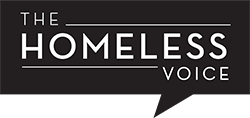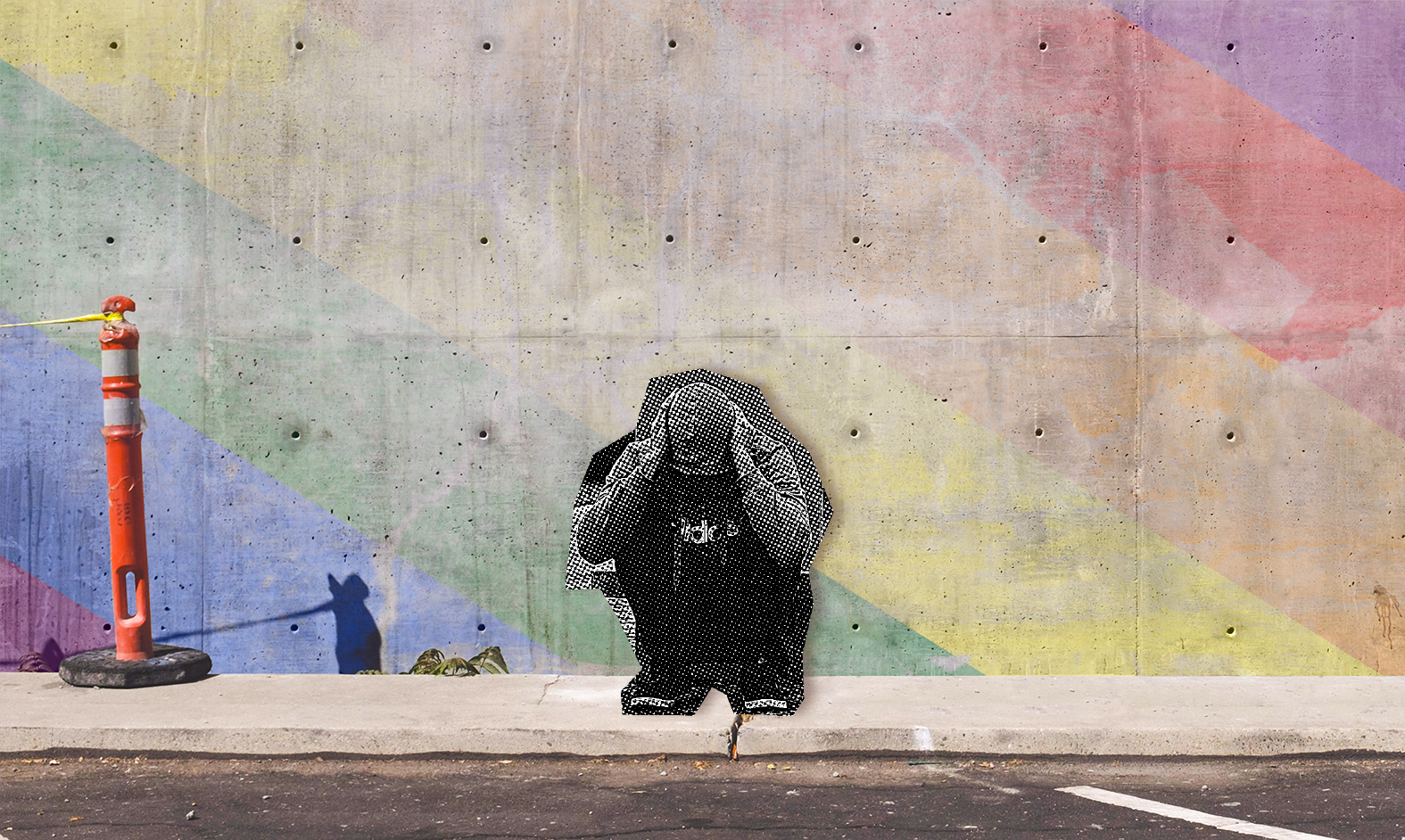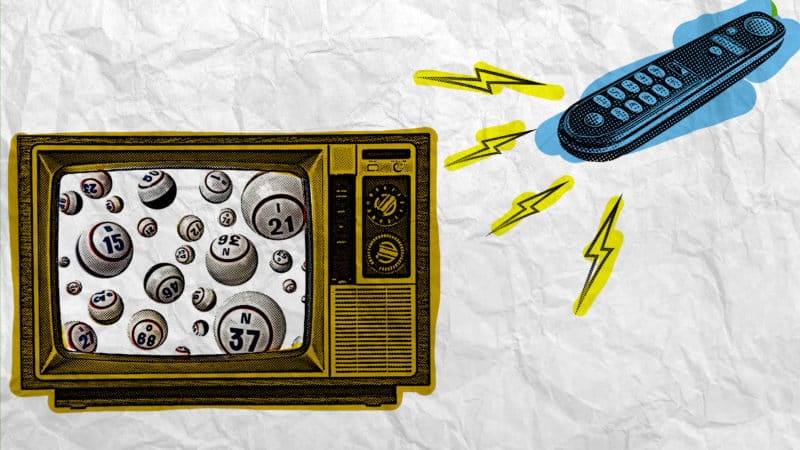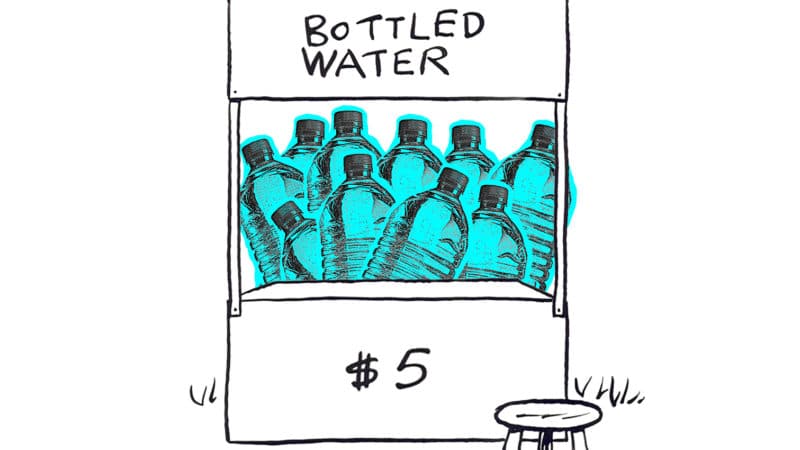Disproportionately representing homeless youth, depressed and anxious, suicidal and unhoused: homeless LGBT youth now face even more challenges due to COVID-19
By Andrew Fraieli
“I locked myself in a public bathroom so I had a place to sleep.”
This was the start of becoming homeless for Reginald Collins, 23, who has been homeless “on and off” since 18. Collins, who is Black, is also gender fluid and prefers both feminine and masculine pronouns.
“It all started when I was 17. My dad kicked me out because I had a few male friends over,” he said. “It went from being a great experience to police getting involved, and child services. I ended up in foster care.”
Collins has stayed at five different shelters as he’s been homeless, not all LGBT-friendly, as well as couchsurfed with what he considered friends at the time.
“My father was Southern Baptist, so very anti-LGBT+, very old-school. He grew up in the ‘60s, very different from the generation of today,” he elaborated.
Collins faced racism, mental health struggles, and intolerance to his gender fluidity during his stays at various shelters. And he is not alone.
Disproportionately harassed and sexually assaulted; depressed and anxious; suicidal and unhoused; LGBT youth face challenges everyday that homelessness exaggerates and the pandemic has exacerbated.
“28% of LGBTQ youth who experienced housing instability reported a suicide attempt in the past year,” according to a 2020 report by the Trevor Project, a non-profit organization focused on suicide prevention among the LGBTQ community. This jumped to 34% for specifically transgender and non-binary homeless youth.
But this was the reality before COVID-19.
Pre-pandemic, 29% of all LGBT youth, generally defined as ages 13 to 24, experienced homelessness — disproportionately representing homeless youth in general, being 2.2 times more likely to be homeless than their non-LGBT peers.
On an average day, 27% of homeless LGBTQ youth reported exchanging sex for “basic needs,” with 38% reporting they had been forced to have sex. On a normal, non-pandemic night, LGBT youth faced violence due to their gender or sexuality, and harassment — in school, by their family, and on the streets.
These disparaged LGBT youth heavily depend on LGBT community centers and shelters for finding housing, as well as finding jobs, mental health counseling, food, showering, and social support. But the pandemic has challenged shelter’s and community center’s ability to supply these essential services, and youth’s ability to receive them. Already, the pandemic has directly caused more LGBT youth to become homeless.
COVID-19 Sending More LGBT Youth to the Street
“When the parks closed, and the hotels closed, we saw a drastic increase in homelessness, oftentimes it’s just them not able to afford rent and getting kicked out of their current situations,” says Heather Wilkie — CEO of the Zebra Coalition in Orlando, one of about 15 or so LGBT-focused community centers in Florida. Wilkie says they see many youth working in tourism and hospitality, and Orlando was already in the midst of a housing crisis when the pandemic started.
Collins was one of those youth, losing his job at a Holiday Inn resort in mid-March. He thought he’d lose his hours for a few days, but it “went from being a few days to a few weeks to months.” Eventually he said they laid him and others off so the employees could apply for unemployment benefits.
In comparison to losing housing, Victor Diaz-Herman — CEO Pridelines, an LGBT community center in Miami — has seen some youth running away from home.
“Because it’s unsafe, or they’d rather be on the streets than living their lives not acknowledging who they truly are, or their parents not wanting to acknowledge who they truly are…,” he said.
The main challenge he’s seen is finding housing during the pandemic due to limited beds in general — rather than more LGBT youth becoming homeless. Second to that is finding shelters “that are safe and affirming for our queer youth.”
The pandemic is now adding on to this series of challenges with COVID test requirements and self-quarantining, both of which can be complicated for a homeless youth Diaz-Herman explained.
The Zebra Coalition has 11 beds of their own for youth coming in, and 36 units in a rapid-rehousing program funded by a grant from the U.S. Department of Housing and Development (HUD). The rapid-rehousing is a rent-subsidy program, so youth do not have to pay. Even so, Wilkie says the Zebra Coalition has faced a similar restriction issue with housing.
“With the rapid rehousing program we’re working with landlords, so we’re at their mercy as to what guidelines they have established because of the pandemic,” she said.
More Restrictions Means Less Help and Longer Waits
Sobourney Burnes — director of the Youth Program at SunServe, a non-profit LGBT community center in Fort Lauderdale — has found similarly to Diaz-Herman that the “difficulty of getting [LGBT youth] housing has increased.” She’s also had difficulties with restrictions implemented at shelters, calling them too restrictive even with safety concerns taken into consideration.
“It’s not fair to someone with a job,” Barnes explains. An example she gives is a client she’s been working with for a couple months who hasn’t been able to stay in a shelter due to working later than the shelter’s curfew.
All three of these LGBT community centers have had to limit in-person interactions and heighten safety restrictions due to the pandemic, but Burnes says they’ve curbed their ability to help.
“We used to be able to go out,” she says. “I could put a kid in my car and drive them to a job, but now with the restrictions I can’t at all.” To Burnes, this forced “less of the hands-on-ness that we’re known for.”
Essential services from LGBT community centers like food, laundry, and mental health counseling haven’t ceased though, in Florida or otherwise. According to one report, during the pandemic some of those needs have increased.
“Many centers have expanded their basic needs programming, such as food pantries and providing direct cash assistance to community members,” states the report from Centerlink, a non-profit coalition of LGBT community centers.
“People don’t understand, when you’re homeless you go through a lot to get back on your feet, it’s not easy. You don’t have a place, you don’t have WiFi. If you don’t have a working phone than that’s even worse because now, with COVID, everything is online,”
Diaz-Herman elaborates that these in-person restrictions have harmed homeless youth, they can no longer “spend time inside, while using the services, or even having a rest from the day to day challenges they face, including access to peers and support services from the shelter,” he said.
But Pridelines continues to offer these essential services.
“[We] still offer our wrap around services, our support groups are virtual,” Diaz-Herman said. “We still have our showers available by appointment, laundry service available by appointment, snacks and meal support — all of that still exists…”
Meanwhile, the Zebra Coalition has even been able to have some walk-in hours stay available during the week. Though Wilkie says, “there haven’t been a lot of youth dropping by, so even though we follow CDC guidelines, they’re still hesitant to come in person.”
Pandemic is Bringing Mental Health Even Lower
COVID-19 restrictions have caused queer youth to have even less access to safe spaces like LGBT community centers and schools which, normally, are heavily used for their community, support groups, and in-person mental health services.
By July of last year, 94% of participating centers offered online programs. That’s up from 21% in early 2020 according to Centerlink’s report, but the participation of these online services is varied. Going online isn’t as easy as it sounds for homeless youth, who may not have readily available access to the internet.
“People don’t understand, when you’re homeless you go through a lot to get back on your feet, it’s not easy. You don’t have a place, you don’t have WiFi. If you don’t have a working phone than that’s even worse because now, with COVID, everything is online,” says Collins, who’s been staying at the Zebra Coalition since he was 19. During the pandemic he’s has been able to access services in person there.
“When you’re experiencing homelessness you aren’t prioritizing sitting at a McDonalds or a Starbucks using their free WiFi to participate in a [support] group in front of strangers,” says Diaz-Herman, referencing their online group services.
Pridelines, he says, has seen a drop in participants since switching to online.
“People are now having to access these groups, more often than not, from their homes where they may not be out, or where it may not be safe to be themselves,” he said.
He sees the shift from a safe place as the main issue, “because now it’s no longer in this space that we create, but the space they have available to them.”
Wilkie described seeing a similar issue where LGBT youth “may be in situations where their families might not be supportive, so that’s further isolating. And all of those things, definitely have expanded.” Wilkie also said they’ve hired more workers for their online mental health services to be able to reach out to even more youth.
School closures could also contribute to LGBT youth’s isolation according to an April report on COVID-19’s possible mental health effects by the Trevor Project. The reports states LGBT youth “may lose access to positive connections,” like extracurricular activities, positive social interactions, and Gay Straight Alliances (GSAs).
“GSAs provide LGBTQ youth and allies with safe environments where they can feel empowered, socialize, and receive support, and the presence of GSAs has been found to significantly reduce the risk for depression and increase well-being among LGBTQ youth and young adults,” according to the report.
These are the same queer youth whom half have been verbally harassed in school and are twice as likely to be physically assaulted there than their peers. For those without a home though, school could be the only source of “positive connections” outside of community centers.
The Humans Rights Campaign took note of the higher rates of homelessness among LGBT youth in a recent report.
“Many LGBTQ youth may heavily rely on food and resources provided by public schools and child welfare agencies. Due to widespread school closures as a result of COVID-19, LGBTQ youth are at risk of accessing basic needs provided by schools,” the report states. “They may also be required to spend more time in unsupportive environments — including home environments where they face family rejection.”
In August, The Trevor Project published their first report that polled both LGBT and straight cisgender youth on their mental health specifically during the pandemic. It found higher rates of stress, symptoms of depression, and that general lack of access to mental health care had increased in the LGBT youth, with the possibility of homelessness contributing to these rates worsening.
When the parks closed, and the hotels closed, we saw a drastic increase in homelessness, oftentimes it’s just them not able to afford rent and getting kicked out of their current situations,
“Forty-one percent of LGBTQ youth stated that COVID-19 impacted their ability to express their LGBTQ identity, including more than half of transgender and nonbinary youth (56%),” the report states. This is also seen in a Trevor Project report from earlier in the year stating that 50% of transgender and nonbinary youth were kicked out of their homes, and 56% ran away due to their LGBTQ identity.”
“LGBTQ youth who experienced housing instability were twice as likely to report seriously considering suicide and three times as likely to report attempting suicide compared to LGBTQ youth who had not,” according to a 2019 version of the same yearly report.
The Trevor project also told the Homeless Voice that, “Since the onset of COVID-19, the volume of youth reaching out to The Trevor Project’s crisis services for support has increased significantly — at times double our pre-COVID volume.”
Collins has felt this stress from the pandemic, saying that his mental health was affected “when the pandemic first started because I lost my job. I got laid off because of this thing. I wasn’t making money for almost five months basically.”
He calls himself a social butterfly, so the lack of “going out, being with friends, doing what young people do: clubbing, going to restaurants, theme parks” has affected him a lot. He also hasn’t been able to see his partner.
The mental health of LGBT youth has already been the subject of many previous reports before. They show higher rates of depression, anxiety, and suicidal thoughts and attempts compared to non-LGBT youth, as well as higher rates of homelessness. Mental health issues are even more prevalent among those who are both LGBT and unhoused.
Helping LGBT Teens will Help All Teens
Mental health is still a problem for cisgender youth though. The Trevor Project has shown that 23% of cisgender youth who “experienced housing instability” attempted suicide as well. The issue for LGBT youth is how disproportionately represented they are. 29% of all homeless youth identify as LGBT, and 28% of those youth have attempted suicide.
“Really we’re talking LGBT youth because they are so much of the homeless youth,” says Dylan Waguespack, the Public Policy and External Affairs director at True Colors United, a non-profit that pushes for policy changes to support homeless LGBT youth. Waguespack points out that anything that works for LGBT youth will work for others; it’s a matter of inclusion in consideration.
“They have to think ‘will I be safe here sleeping, I can’t come out, I can’t say this is who I am, someone is going to hurt me’,” says Burnes — non-LGBT youth do not. In one shelter, she says “there was a lot of LGBT incompetency,” and the common situation of a trans youth being put on a side of the shelter that doesn’t match their gender.
“I went to a Christian shelter and that was one of the worst experiences I ever had,” says Collins. “It’s definitely one of those full-time Christian places. Me being Black, the power of them being a bunch of caucasian people, there was some little racism going on. At the time, I was just going to school, trying to live my day-to-day life.”
Collins is also familiar with the shelter Barnes was referring to.
“[T]hat was another Christian faith shelter, but they did understand they had a LGBT population. So they were more tolerant — I should say, ‘tolerant,’” he said. “Shelters like that need to educate themselves on modern day society, you know, asking pronouns, knowing how to identify gender, becoming more open to LGBTQ youth. Have to be more patient…”
It’s always been true that housing is the solution, There’s no reason to be spending tax dollars to keep warehousing young people.
“To be fair, congregate shelters haven’t always been the greatest option,” Waguespack notes. LGBT youth end up there “knowing they are less safe in congregate housing: mentally, physically, or otherwise.”
Most of True Colors United’s “focus is on trying to help spur congressional action,” Waguespack says. Right now “there isn’t much to be done except crisis management,” and making sure young people are included in emergency situations and spending decisions.
Diaz-Herman points to the need for more training for staff at shelters and to have the conversations about how to make LGBT youth feel safe, even with other non-LGBT clients.
“So when you come into that space, if you’re a straight ally, you are coming in knowing that this space is safe, it’s affirming, but knowing it’s first and foremost going to ensure that our LGBTQ community members are the ones that feel that,” he said.
A report from True Colors United highlights the possible lack of training showing that 22.7% of shelters said “they did not have dedicated LGBTQ staff and did not need one.” 30.3% reported they didn’t have a dedicated staff member but it would be helpful, with the main reason of going without being funding.
Funding is always a problem, but going further, how the dollars are spent is an issue as well. Waguespack hopes more money is used for better conceptual solutions, like housing support, rather than furthering shelter capacity.
“It’s always been true that housing is the solution,” he said. “There’s no reason to be spending tax dollars to keep warehousing young people.” And, he continues, along with that idea, “none of these things will be less important months from now.”
Wilkie agrees.
“Young people aren’t going to suddenly have housing in three months. It’s a long-term issue, they’re spot on,” she said. “I was very fortunate we got that long-term money [the HUD grant] because a young person could stay in that housing program for up to two years — that’s the type of assistance that we need.”
LGBT youth already disproportionately suffer from mental health issues, higher rates of homelessness, and lack of access to help, with the pandemic taking more of these skeletal support systems and scarce resources away from them.
Diaz-Herman hopes, though, that more funding will come from this dire situation to help LGBTQ youth in the long-term.
“Not to provide more beds in existing shelters,” he said. “But to develop specific housing opportunities and programs that are targeted, that is focused on a [Continuum of Care]. Not just to house you, or find you a temporary apartment that you can eventually transition to, but to give you opportunity to pick up a skill.”
Shelter is one step in a more long-term solution the way Diaz-Herman describes it. These LGBT youth need housing, but they also need life skills to truly succeed.
“Financial literacy, professional development, support with mental health — well, health and mental health quite frankly — that would be focused on providing these young people with the resources to become self-sufficient,” he explains. “So, when they either age-out or term-out of these programs, they have the ability to thrive.”
Collins is a perfect example of what more long-term services can do. He’s stayed with the Zebra Coalition, a place he calls “very pro-LGBT,” three times since he was 19, but sees this as the last time.
“I don’t plan on coming back, because I’ll have my life together,” he said.
He’ll be starting a job soon as an assistant administrator at Aspire Health Partners, a Florida behavioral healthcare non-profit, helping HIV affected men and women find housing.
“I’ll be doing pretty much what my life has been about,” he said. “And I’ll put it back into the community.”
Without the Zebra Coalition — where he’s stayed since the pandemic started in January 2020 — Collins paints a grim picture of what his life may have been like.
“I’d probably be dead somewhere,” he said. “I would have either died from starving, or dehydration, or I would have gotten so depressed at the situation because I had no help, nowhere to go…”
But when it’s all over, “I expect life to be better. I expect to travel. I think people will feel a lot better after this mess.”



